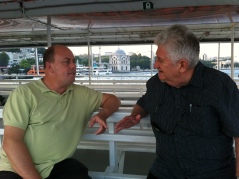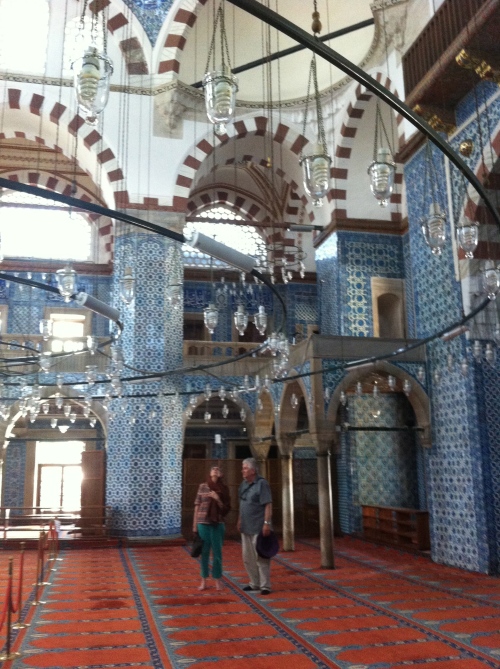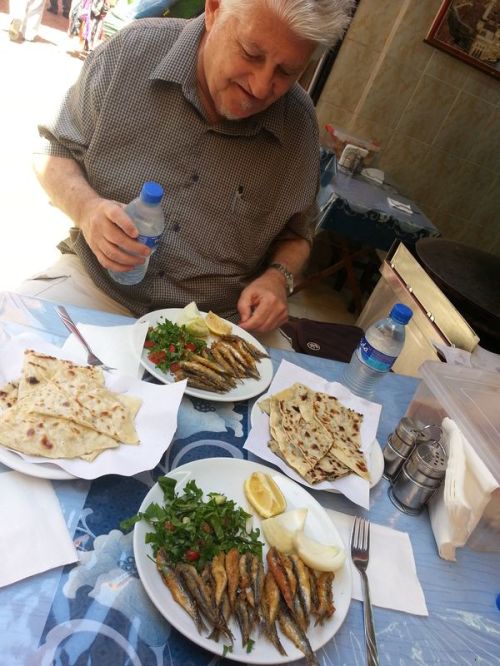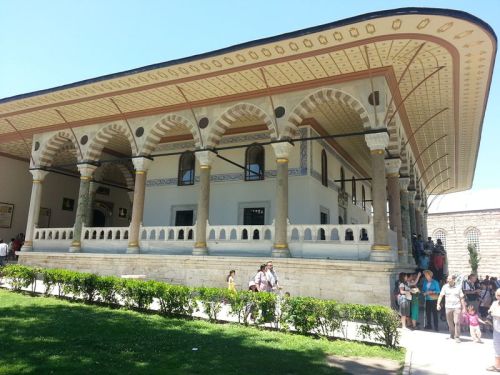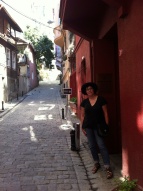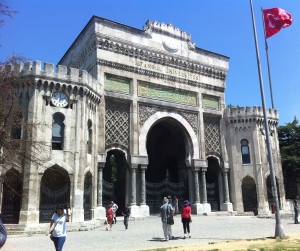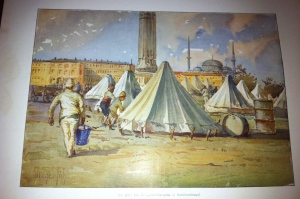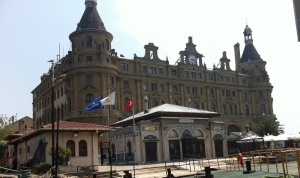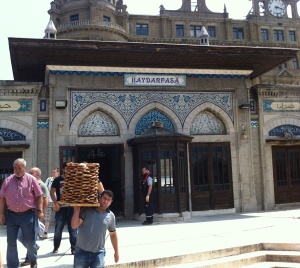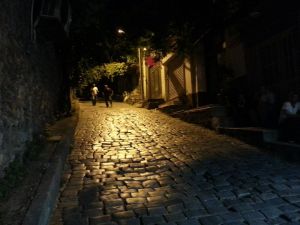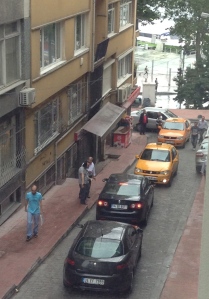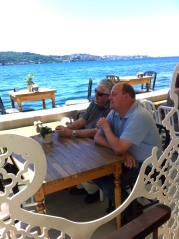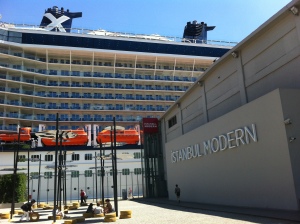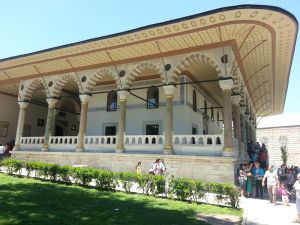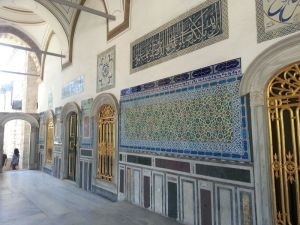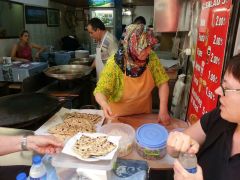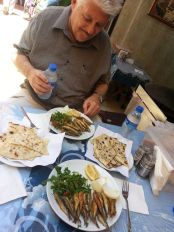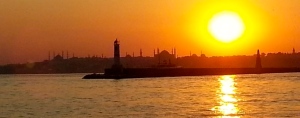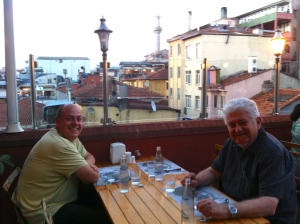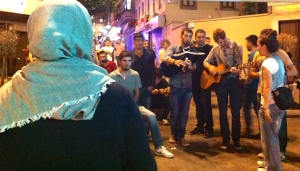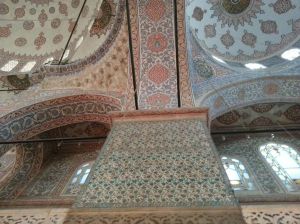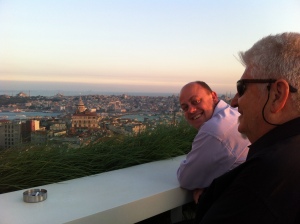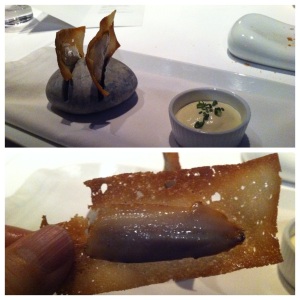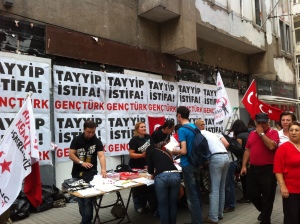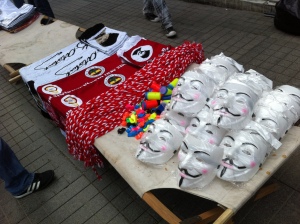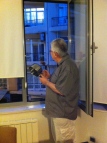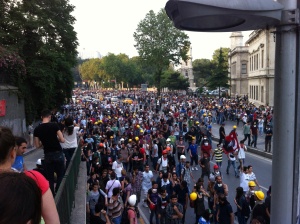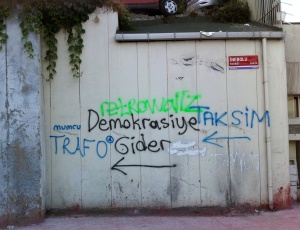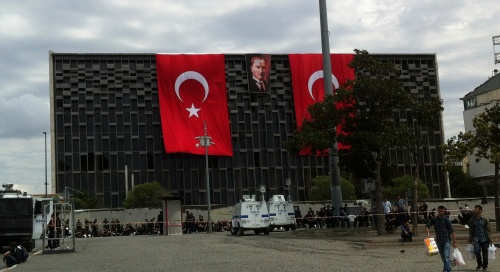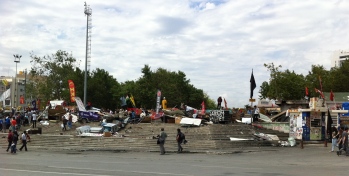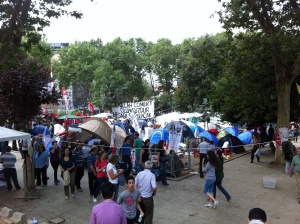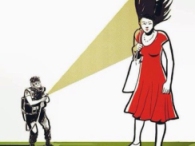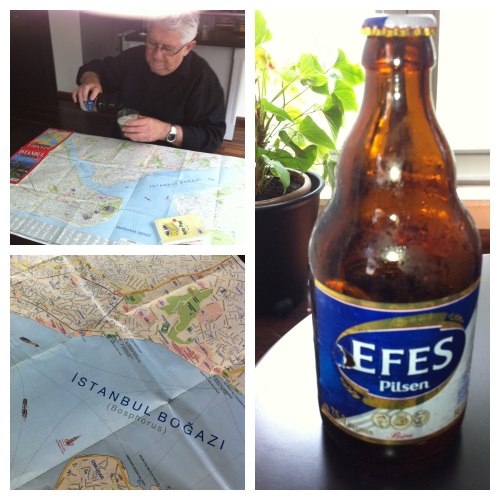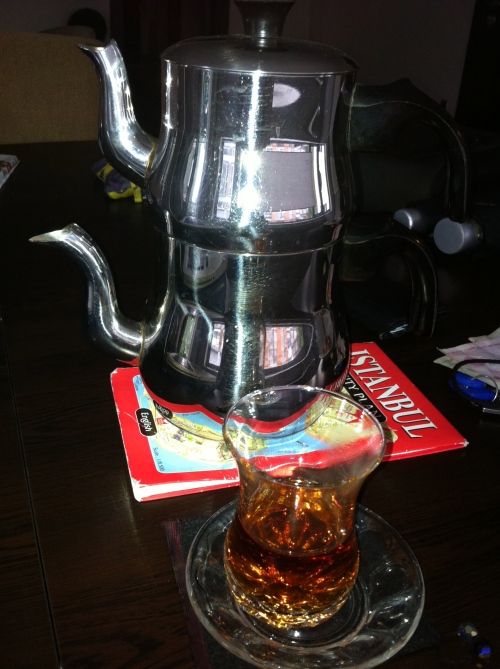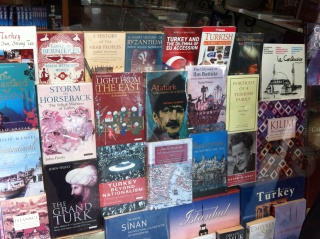 One of our “small ceremonies” while travelling is to seek out interesting fiction based in the cities we are visiting. This seems to be a lot easier now than it was in the past. We recall an English bookshop in Rome in the 1980s being rather bemused by our request for a recommendation for a novel with a Roman setting.
One of our “small ceremonies” while travelling is to seek out interesting fiction based in the cities we are visiting. This seems to be a lot easier now than it was in the past. We recall an English bookshop in Rome in the 1980s being rather bemused by our request for a recommendation for a novel with a Roman setting.Category Archives: Istanbul
Virtual reality
 One of our “small ceremonies” while travelling is to seek out interesting fiction based in the cities we are visiting. This seems to be a lot easier now than it was in the past. We recall an English bookshop in Rome in the 1980s being rather bemused by our request for a recommendation for a novel with a Roman setting.
One of our “small ceremonies” while travelling is to seek out interesting fiction based in the cities we are visiting. This seems to be a lot easier now than it was in the past. We recall an English bookshop in Rome in the 1980s being rather bemused by our request for a recommendation for a novel with a Roman setting.John and Helen’s Istanbul Top Ten
After two wonderful weeks in Istanbul, we took the caravan road out of that remarkable city and into the wilds of Turkey Major. Our camels were cleverly disguised as a comfy Mercedes Vito, and Istanbul was soon just a haze of shimmering minarets in the distance. But even now, back at home in Melbourne, we have vivid memories of our time in the Ottoman capital. So, before we get to the tales of our trip through southern and central Turkey, with the benefit of a little reflection and in no particular order, here is our Top Ten for Istanbul:
Crisscrossing the Bosphorus – Going from Europe to Asia and back, in an assortment of ferries, was an oft-repeated pleasure. It was a ride long enough to feel purely vicarious, but short enough to not require much consideration of timetables; one accompanied by people going to work, to shop and to eat; and serviced by charming sellers of tea and large round cream wafers that, like so many small items, cost just 1 TL each.
Pots and Pans – The subtle but powerful domestic protest that occurred each evening at 9.00pm impressed us greatly, and quickly drew us in as participants. Many residents of inner city Istanbul chose this personal (but teargas-free) way to declare their support for the Taksim Square protestors, and their opposition to the moralistic and heavy-handed tactics of Prime Minister Tayip Erdoğan.
In a spectacular demonstration of their poor political judgement, and their inability to lead Turkey towards the future, the Turkish Government has just outlawed banging on pots and pans!!
The Market Streets of the Old Town – While the Grand Bazaar and the Spice Market are fascinating and bustling, they have always been very popular with tourists, and hence bring relentless approaches by touts. 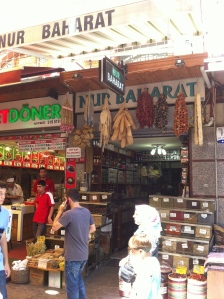 Much more interesting, and less confronting, are the maze of streets surrounding both bazaars, which offer a much wider range of goods, and a more colourful (and largely local) clientele. Many hours can be wasted quite productively here.
Much more interesting, and less confronting, are the maze of streets surrounding both bazaars, which offer a much wider range of goods, and a more colourful (and largely local) clientele. Many hours can be wasted quite productively here.
Rüstem Paşa Camii – We thoroughly enjoyed visiting mosques (camii in Turkish, pronounced “djarmy”) all over Istanbul. There’s the imposing Sultanahmet Camii (the Blue Mosque) with its blue and green Iznic tiles, but always full of tourists, and the calmer and more subtly designed Suylemaniye Camii, virtually without any tiles, near Istanbul University. However it was the intimate scale, the hidden entrance, the welcoming loggia and the rare red-tinged Iznic tiles of the Rüstem Paşa mosque at Eminönü that we found truly impressive, and most serene.
Street Cafes – The most rewarding food experiences, and some of our most enjoyable meals, were to be found in the small family-run street cafes, where we got by with goodwill, some basic knowledge of Turkish food and very little English. The Gözleme and fried Hamsi (sardines) near the hard-to-find entrance to Rüstem Paşa, and the Kaymak (clotted cream with honey) and Suckuk (Turkish salami) with Eggs at Pando Kaymakçi in Beşiktaş, run by 88-year-old Pando and his family, were absolute triumphs.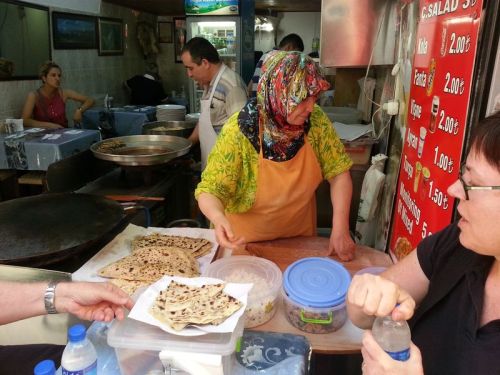
Chora Mosaics and the City Wall – Reflecting the more conventional archaeological layers buried in the earth, Turkey displays a veritable smorgasbord of cultures and empires above ground as well. In a large city like Istanbul, where only substantial ruins survive the demands of redevelopment, it is surprising to find so much of the old city wall (breached by 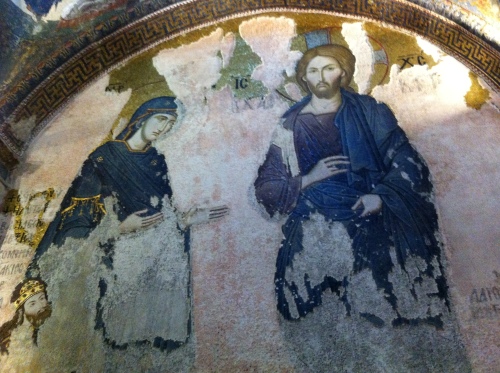 Mehmet the Conqueror in 1453) still standing, albeit subsumed into private yards and public parks in many places. A ferry ride up the Golden Horn and a fascinating walk alongside the wall brings you to the Chora Kariye (Church). It was built by the Greeks in the early 12th century, and rebuilt a few times since. It is always filled with tourists, but its walls are covered with the most astounding mosaics. The mosaics largely survived the post-Mehmet conversion to a mosque, and depict, in fine and beautiful detail, the lives of Mary, JC and the Apostles.
Mehmet the Conqueror in 1453) still standing, albeit subsumed into private yards and public parks in many places. A ferry ride up the Golden Horn and a fascinating walk alongside the wall brings you to the Chora Kariye (Church). It was built by the Greeks in the early 12th century, and rebuilt a few times since. It is always filled with tourists, but its walls are covered with the most astounding mosaics. The mosaics largely survived the post-Mehmet conversion to a mosque, and depict, in fine and beautiful detail, the lives of Mary, JC and the Apostles.
Basilica Cistern – We are always impressed by good public architecture and innovative infrastructure, and that’s not just because we’ve both worked a lot in government. The Yerebatan Sarniçi (Sunken Cistern) was built by Constantine and the Romans under what is now Sultanahmet in the 4th century, to provide water for the capital, and later the palaces, with the water being brought by viaduct all the way from the forests in neighbouring Bulgaria. The engineering is impressive, and the structure was so well made that it still supports a number of city buildings at street level, even though it has long since ceased to have a functional role as a reservoir. 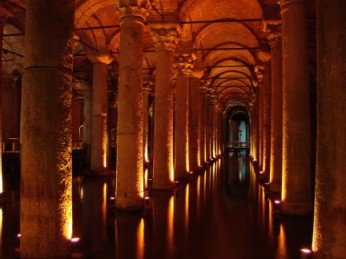 The space is also extremely beautiful. Despite being a totally utilitarian and underground facility, the Cistern boasts excellent design and even several decorative features. The lines of the 336 columns with their solid bases and decorated tops, the brick domes that provide the strong roof structure, and the special features like the two stone carvings of Medusa, are all beautiful, even though they would have been underwater in their original incantation. And as long as you go late in the day and avoid the crowds, the Cistern is also as serene as a large church or camii.
The space is also extremely beautiful. Despite being a totally utilitarian and underground facility, the Cistern boasts excellent design and even several decorative features. The lines of the 336 columns with their solid bases and decorated tops, the brick domes that provide the strong roof structure, and the special features like the two stone carvings of Medusa, are all beautiful, even though they would have been underwater in their original incantation. And as long as you go late in the day and avoid the crowds, the Cistern is also as serene as a large church or camii.
Topkapi Palace Library – There were many highlights at the huge complex that comprises the former home of the Sultans, including treats for we former bureaucrats like the Divan (pronounced “di-waan”) – the rooms where the governing and the judging was done by the Vizier and his factotums, under the watchful but mostly invisible eye of the Sultan. Amusing also for us was the comparison with the inappropriately European style of the replacement Dolmabache Palace, built as the Ottoman Empire expanded and the Sultans sought to “modernise”, just north of our digs in Kabataş. But it was the simplicity and design of the Topkapi Library, with its luxurious divans (yes, our word for couches is Turkish), the deep windows on all sides to catch the breezes, the elaborate ceiling and the ornate cupboards for the books, that most took our fancy.
Tea – Turkey runs on çay (pronounced “chai”). It is drunk repeatedly, and always seems to be available. Obviously it is served in homes and cafes, but it is part of the bargaining process in shops, is sold on ferries and in markets, and is constantly being carried to anywhere that groups congregate, 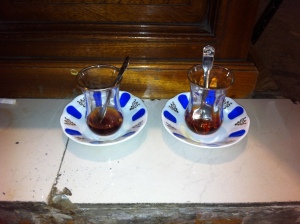 on trays that employ a suspension handle that allows safe movement of a full tray of tea. Every step or stool sports a tea drinking man, and a few women, and every corner holds empty cups awaiting collection. This is the most public of tea ceremonies – anyone, anywhere, anytime.
on trays that employ a suspension handle that allows safe movement of a full tray of tea. Every step or stool sports a tea drinking man, and a few women, and every corner holds empty cups awaiting collection. This is the most public of tea ceremonies – anyone, anywhere, anytime.
Modern Istanbul – Despite its age and its many layers, Istanbul, well the inner-city at least, is a very modern city, and probably deserving of a Top Ten all of its own. The terrace bar and the Mikla Restaurant at the Marmara Pera Hotel offer stunning views, great drinks and a top-notch degustation menu.
More affordable and in a less dramatic location, Lokanta Maya in Karaköy gave us the best meal of our month in Turkey. There were also a lot more locals amongst the patrons. It was the same mix of visitors and locals for breakfast at The House Café, waterside in Ortaköy, though the affluent Istanbul-ites were less than subtle here about showing their wealth. The Museum of Innocence, the eponymous creation that actually post-dates Nobel Prize-winning Orhan Pamuk’s novel, is of course an essential temple for Western visitors, particularly those in a book group back home. And who could forget the Istanbul Modern – their surreal entrance, and their wonderful video piece Road to Tate Modern, which we did not realise at the time was to become the theme for the rest of our time in Turkey – on the caravan road.
Constantinople not Istanbul
With the arrival of Teyze Jan at the beginning of the week, we kicked off the family history part of our trip to Turkey. Helen’s grandfather (Jan’s father), Sergeant Maurice Delpratt was captured on the Gallipoli Peninsula and spent three and a half years as a prisoner of war working on the Berlin to Baghdad railway in the remote Taurus Mountains near the southern Syrian border.
We will be visiting many of the places where he was held – a journey of around 1,500 kms across Turkey.
But we start in Istanbul, or Constantinople as it was in 1915. What is now the University of Istanbul was the Turkish Ministry of War; and it was here that prisoners were brought for processing. They came up from the battlefields probably in boats returning to Istanbul, and were marched over the Galata Bridge and through the city streets, to the prison at the Ministry of War.
Teyze Jan had only two days in Istanbul, so on the first day we combined a visit to Sultanahmet (the justifiably famous blue mosque) with a stroll through the Grand Bazaar to the university campus. We passed through the same stately gates that the prisoners would have passed through in 1915. While we were sitting in the shade of the trees in the inner courtyard, the midday call to prayer began from the beautiful Suleymaniye mosque nearby.
We thought about those anxious men, feeling ashamed at their capture and apprehensive about what was about to happen, hearing such a foreign and spine-tingling sound from their cells.
The other place in Istanbul that is part of Maurice Delpratt’s war is Haydarpaşa Railway Station. Another graceful edifice, this building was a gift from the German Kaiser to the Sultan and was an important part of the Berlin to Baghdad Railway.
It was opened just before the war and sits on the Asian side of the Bosphorus with its own dinky ferry station. It was here that Maurice and the other prisoners were loaded onto the train in July 1915 to take them to prison camps in central Turkey for the remainder of the war.
The train was headed to Afyonkarahissar in central Turkey, which was a major distribution point for prisoners to other camps around Turkey. On the way, the train was shelled by a British submarine. Maurice later wrote in a letter home, “But quite the most fearsome moments of that eventful time, were some we spent in a stationery train, close to the Gulf of Isnet [now Iznik]. A submarine opened fire on the train and we spent an anxious half hour, trying to hide from one another, a very hearty desire to dive under the seats. At Angora [now Ankara] a few months afterwards I met the huge West countryman who served the gun. He was Hooper of E7 and now keeps a watch in the compressor room at Tasch Durmas [as a fellow prisoner in the Taurus Mountains].”
Our next stop is the Gallipoli Peninsula, where both Maurice Delpratt and John’s grandfather, Ernest Strambini served.
Filed under Delpratt, Istanbul, POW history
The Road to Istanbul Modern
As Charles Atlas would have it, Istanbul is a place of dynamic tensions.
For the visitor of course, these contrasts are both exciting and challenging. We have been intrigued by traditional Istanbul, hugely impressed by ancient Istanbul, and quite confronted by religious and conservative Istanbul. Not surprisingly, we are most comfortable with modern Istanbul, even though that’s not without its challenges.
After almost two weeks here, some recurring themes are appearing. Eating and restaurants of course, and the Taksim protests, but an unexpected theme of considerable importance has turned out to be roads.
 Before the Taksim protests showed just how differently the government and their supporters were thinking, most would have said that Turkey was roaring down the road to modern Turkey, European Turkey, and certainly modern Istanbul.
Before the Taksim protests showed just how differently the government and their supporters were thinking, most would have said that Turkey was roaring down the road to modern Turkey, European Turkey, and certainly modern Istanbul.
Just how on earth Erdogan thinks he can put that genie back in the bottle defies all logic. While the crushing of the protests, which he has all but achieved, will slow things down a bit, nothing will stop the path that Istanbul is on.
There is of course a short-term cost, and the European media are suggesting that the violent and duplicitous way that the PM has reacted to the Taksim protests has finally killed off Turkey’s desire to join the European Union. However, if they manage to get the Olympics in 2020, Istanbul will move even further away from Erdogan’s Turkey.
Our road to modern Istanbul has of course been a little more pedestrian (heh heh).
Being quite literal, the actual roads are crazy, like the small one-way street we are staying in, where cars just ignore the rules and drive straight at each other. The really steep streets falling away from Beyoğlu and Istiklal Street are also a wonder to behold.
Back in the metaphorical, while we have loved the uber-cheap street cafes and old fashioned shops and markets, we have also really enjoyed the upmarket restaurants and fashionable neighbourhoods that are an equal to any modern city.
We had a superb meal at Lokanta Maya (Kemankeş Cd, Karaköy) run by New York trained Istanbul chef Didem Şenol (though she is off having a baby at the moment). We breakfasted on the Bosphorus at The House Café at Ortaköy (Salhane Sk), surrounded by wealthy and very modern locals.
But we probably had the most modern fun on our visit to the Istanbul Modern, which turned out to be a very telling metaphor for modern Istanbul.
The road to the Istanbul Modern is in fact an ugly driveway into a carpark, with no dedicated space for pedestrians. The entrance is at the end of said carpark, and looks like the sign-on shed for crew for the nearby docks. The museum building itself fares no better, sandwhiched between a machinery storage yard and the docks. On a good day, the docks provide a spectacular view of the Bosphorus and the Asian side from the museum café; problem is, on most days, there is a huge cruise ship docked there, totally blocking the view.
Once inside, the Istanbul Modern is the very model of a modern major art museum, and fortunately the current exhibitions included a major retrospective of their collection, Past and Future. Populist at one level, but a great opportunity for the one-time visitor.
There was also a very strong retrospective of local artist Erol Akyavaş.
But to prove that Art Imitates Life just as often as the other way around, our favourite piece in the Istanbul Modern retrospective was a video piece by two Istanbul artists titled …….
[It’s only 6:41 long but you can skip to 4:55 and get the gist]
Filed under Culture, Food, Istanbul, protests, Restaurants
Deutsche?
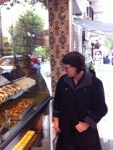 As those of you who’ve been to Istanbul know, the tour touts and souvenir sellers who hang round the big tourist sites in Sultanahmet play a game of guessing your nationality to engage you in conversation. It’s probably not a good thing to be assumed mostly to be German.
As those of you who’ve been to Istanbul know, the tour touts and souvenir sellers who hang round the big tourist sites in Sultanahmet play a game of guessing your nationality to engage you in conversation. It’s probably not a good thing to be assumed mostly to be German.
So it was a happy day today – “French..?”
First fifty hours, Part 2
… in which we hear more of the adventures of Pasha Phil meeting up with effendi Helen and John in Istanbul.
There are a lot of must-see places in Istanbul, where notwithstanding the lines of buses that arrive from the cruise ships, you have to take your place in the queue or miss out on astonishingly beautiful sights.
So on the next day, we set off to Topkapi Palace, the former palace of the Sultans in Sultanahmet. Not a European-style palace rather a beautiful garden complex filled with lavish pavilions. More stunning tiles and marble and opulent design. A library to die for, with thick walls against the heat, lounging couches and windows to pick up a breeze coming from any direction. A kitchen that accommodated 1,500 staff.
The Divan (yes named after the couches that lined the walls) is the Cabinet Room, where the Sultan could slip in unobserved and listen behind an ornate grill to his advisors arguing about policy and judging disputes. Clever way to keep the court on its toes.
After all that opulence, lunch was in a tiny family café down in the market streets near the Spice Bazaar (Uzunçarşi Cd). One each of a spinach, cheese and potato Gozleme, cooked by the mother, and two plates of deep-fried Hamsi (sardines) cooked by the father, with the son doing the serving. All brilliant, and with three waters, it cost a whole 40 TL.
The Palace had taken longer than we expected, so our afternoon plan – to ferry up the Golden Horn and walk to the Chora Church Museum – no longer seemed viable.
Plan B, created on the spot, was to hit the water – it was a beautiful day, after all, and a ferry to Üsküdur (Asian side) was approaching. After a Monty Pythonesque interlude, as the ticket seller dealt with a sudden power failure by scrambling to fire up a generator for the electronic reader of our Istanbulkarts, we were headed home, but via Asia.
Back at our Kabataş apartment, we shared a glass of one of Turkey’s better red wines, and planned some more adventures – a re-run of our Chora plan for the following day; a visit to the Istanbul Modern; a special breakfast in Besiktaş; an underground tour of the Basillica Cisterns; and making a booking for dinner for Phil’s last night at Lokanta Maya.
Then we headed out again to catch another ferry across the Bosphorus back to Kadiköy, to yet another great restaurant. And impressively, to three more Standing Man silent protest groups in different locations in Kadiköy, plus at 9.00pm, the enduring pots and pans/knife and glass anti-Erdogan protest from the restaurant patrons.
50 great first hours for a fiftieth, and plenty more great Istanbul hours to go.
Pasha Phil joins us in Istanbul – Part 1
 This is our first real travel diary post about our visit to Istanbul – delayed in part because we’ve been orienting ourselves in this unusual city, and in part because we were a little distracted by the Taksim protests. The arrival of Pasha Phil flicked the switch. The sun came out and we have had an uninterrupted string of perfect days. “Come and use our spare room in Istanbul” was our 50th birthday present to Helen’s brother Phil, and since his arrival on Monday, we have been going hard. So this then is the tale of Phil’s first fifty hours in Istanbul – Part 1.
This is our first real travel diary post about our visit to Istanbul – delayed in part because we’ve been orienting ourselves in this unusual city, and in part because we were a little distracted by the Taksim protests. The arrival of Pasha Phil flicked the switch. The sun came out and we have had an uninterrupted string of perfect days. “Come and use our spare room in Istanbul” was our 50th birthday present to Helen’s brother Phil, and since his arrival on Monday, we have been going hard. So this then is the tale of Phil’s first fifty hours in Istanbul – Part 1.
Phil arrived at our Istanbul apartment via a visit to London, a truly generous birthday gift from Mary, Pat and Claire back home in Brisbane, so fortunately there was no time-zone jet lag for him. After an Efes beer and a quick catch up, we were all down to the Kabataş ferry terminal at the end of our street, and off to another continent.
With a spectacular sunset over the European side behind us, we crossed to Kadiköy in the Asian half of Istanbul. We walked through the bustling waterfront district, past dozens of restaurants beginning to fill, and through narrow market streets where the fresh-food stalls were only just beginning to close at 8.00pm. A long day for the fishmongers and fruiterers; even longer for the cake shops and delis. We headed for Ciya Kebap (Guneslibahce Sk), the often-overlooked younger sister to the renowned Ciya Sofrasi opposite (where we have a booking later in the week). All the street-level tables were full, but they directed us up to the fourth-floor roof terrace, even better. We looked out across the rooftops and minarets and the street scene below.
We had two simple gorgeous salads (one with minced tomato, garlic and parsley, and one with thyme, parsley and onion), plus a complimentary dish of chilli-flavoured soft cheese, and two kinds of flat bread. Phil chose the Ciya Kebap (a bread-wrapped minced lamb skewer, flavoured with walnuts), Helen had the Sour Kebap (a flat plate of minced lamb, flavoured with pomegranate and on a bed of eggplant) and John opted for the Poppy Seed Kebap (a minced lamb skewer heavily flavoured with white poppy seed). Everything was superb, and the setting was sublime. Along with three waters and two ayrans (the salty yoghurt drink that traditionally accompanies kebap) the meal cost the princely sum of 90 TL, about AU$20 each.
One tiny concern we had heading across the Bosphorus, was that by going further afield, Phil would miss the nightly “pots and pans” protest in our neighbourhood. Oh we of little faith. On the dot of nine o’clock, a group of young people began to wend their way through the now-crowded street of restaurants, chanting and clapping. Immediately, a huge percentage of the restaurant patrons, including us of course, began to tap their knives on their glasses and plates in support – an astoundingly subtle and atmospheric protest.
After dinner, as we strolled back through Kadiköy, we encountered a group of musicians and dancers performing boisterous Turkisk folk songs with full audience participation, while nearby a group of young contemporary artists were doing shadow puppets over a backdrop of short computer animations projected onto a nearby wall. Nothing left for us now but to head down to the ferry for a return trip across the Bosphorus, to the sparkling lights and minaret skyline of Beyoğlu and Sultanahmet.
The second day began with a traditional Turkish breakfast of white bread, tomatoes, cheese, pastirma, yoghurt, fruit and tea. Then it was off to the treasures of the Old Town. The Kabataş (No 1) tram at the bottom of our street goes straight to Sultanahmet, and then it’s a walk through the Hippodrome, where the scale of the horse and chariot racing track from the Roman days are there if you look carefully.
The Sultanahmet Camii (the Blue Mosque) is unmissable, pretty much unchanged since 1616, if you don’t count electric lights instead of candles, and a PA system on the minarets to assist the Imam’s call to prayer. It is a truly impressive place, with 20,000 mostly blue tiles (from which the mosque’s Western name derives), a high domed ceiling, and the beautiful Arabic script found in all mosques. Even we infidels found this a profoundly moving place – providing you can overlook the “cover all flesh” and “stay up the back, behind the screens” rules that apply to women.
Then on to Hagia Sophia, the world’s fifth largest Christian church (in this, it’s third incantation) and built almost 1500 years ago. It was also a mosque, converted after Mehmet the Conquerer took Constantinople in 1453. Remarkably, the conversion was quite modest, almost respectful and, as part of the creation of the modern Turkish Republic by Kemal Ataturk in the 1935, it was made a museum, retaining clear evidence of its former roles for two faiths.
Now it was time to plunge into modern Istanbul, and the chaotic, narrow and steep market-streets that surround both the Grand Bazaar and the Spice Bazaar, but are far more interesting (and challenging) for visitors than the more formal covered bazaars. Other than undertaking the most intense version of window-shopping imaginable, the main goal for visitors to the market district is to decide which hole-in-the-wall street eatery you are going to choose for lunch, a task we largely handed over to Phil. We pulled up some tiny stools to a tiny table on the edge of the street and had great mixed kebabs for 32 TL. Then more market streets till we’d exhausted ourselves, and home for a relax and freshen up.
In the evening we caught the underground funicular on its short run up to Taksim Square, now without the noisy protests, but still full of people. They stood silently, showing support for the “Standing Man” silent protest that entrances the foreign media, perplexes the police, and frustrates the government with its simplicity. It’s very compelling.
After paying due respect, we headed off down Istiklal Street to the Mamara Pera Hotel and its rooftop Mikla Restaurant. The stunning views from the rooftop bar included an amazing sunset, and of course an ideal spot for a g & t. Then it’s down one level to the restaurant, and an equally stunning seven-course tasting menu (225 TL) with matching wines (120 TL). The first course was the unanimous pick of the night – Balik Ekmek (Crispy Sardines, Olive Oil, Bread, Lemon) – two succulent sardine fillets magically attached to wafer-thin toasts, served sail-like on a slotted stone. The night was long and jolly, the food and wine excellent, and the view over Istanbul brilliant all night. The view got even better when we were moved to the best table in the place, on the corner of the balcony, when those diners finished early.
Life is good. More to come.
Erdogan talks tough… and acts tougher!
 The ground has shifted enormously re the Taksim/Gezi protests in the last two days, and PM Tayip Erdogan has once again shown that what he says and what he does are two quite different things.
The ground has shifted enormously re the Taksim/Gezi protests in the last two days, and PM Tayip Erdogan has once again shown that what he says and what he does are two quite different things.
The negotiations in Ankara with representatives of the protesters appeared to have gone reasonably well, with both sides sticking to their positions, but with the PM seeming to give enough room for the protestors to consider ending the occupation of Taksim Square and Gezi Park. The protesters started dismantling some of the barricades.
Then, on Saturday afternoon, Erdogan reverted to his original hard-line position, and demanded that the protestors leave by Sunday evening, or be removed by force. As people poured into the area for what they thought would be a last show of solidarity with those camped in the Park, the police suddenly announced that the crowds had to vacate the area immediately.
Thirty minutes later, with huge force and rubber bullets enhancing the usual tear gas and water cannons, the police attacked en masse, followed closely by bulldozers and workers to remove all traces of the occupation. The street battles went on all night, and apparently there were many injuries.
We had been in the Square only about an hour before, to begin the Istanbul Passeggiata, a long walk down Istiklal Street. There were swarms of unsuspecting people going the other way, up to the Square, with the only indication of what was to come being the very large numbers of police we saw all around the area.
By the time we got home, we were unaware that the police had moved in. However the early and more frantic pots and pans soundscape told us something big had happened, and sent us scurrying to Twitter and Al Jazeera (the only English language TV we have) to find out what was happening. It also sent us to the saucepan cupboard so we could join the solidarity sonata.
The protests continued in many parts of Istanbul today, while for its part the government outed an endless array of absurd conspiracy theories (eg, the substantial coverage of the protests by BBC-World and CNN must have been paid for by some hostile foreign interests, proving that the protests were being run by “outsiders”). They also prepared for their own very large rally of Erdogan supporters on the outskirts of the city.
After returning home this afternoon from a great day Kadiköy on the Asian side of the Bosphorus, we heard the unmistakable sound of a demonstration. Right at the end of our street, on the water’s edge, a huge march went past on its way to Dolmabahçe Palace, and the PM’s Istanbul offices.
The police were there in force, and for quite a while it looked like they would charge, but eventually things calmed down and the protestors dispersed.
As a backdrop to this confrontation, we could see specially decorated ferries on the water carrying Erdogan supporters to his very successful rally.
What seemed most obvious to us was that this political confrontation is far from over.
Call to Taksim
It’s 9.00pm in Kabatas, not far from Taksim Square, and the now nightly sounds of solidarity burst out – the clanging cacophony of Istanbul residents in the Beyoglu district, leaning out their windows and their balconies, beating pots and pans to support the embattled protesters in Taksim Square and Gezi Park.
Tuesday night, while we were still on our way to Turkey, the riot police charged again, without warning, to try to drive the protesters away with tear gas and water cannon and violence. Once again they failed.
After our arrival in Istanbul, we walked through Taksim and Gezi yesterday, and the whole area looked like a war zone.
There were police everywhere around the edges, lounging around and in cafes, but still in full riot gear, and with tear-gas and water-cannon trucks (more like tanks, really) in many strategic places.
Taksim was a shambolic mess of barricades and rubbish and rubble, and signs of fires and fighting. Gezi Park was like Woodstock on the fifteenth day, with hundreds of tents, mountains of rubbish, and every alternative hawker, healer and haranguer you could imagine.
Many wore light gas masks loosely around their necks, and it was a faction factory, with dozens of groups discussing politics and tactics. The more aggressively radical groups were in Taksim, while the biggest numbers, and the greatest diversity was in the Park.
Then today, Prime Minister Erdogan threatened the protesters with even tougher language, despite growing international pressure, and some earlier suggestions of a compromise.
The protests, and Erdogan’s intransigence, is the only topic of conversation here, where the parallels for us to Bjelke-Petersen’s Queensland are a bit too close for comfort.
Erdogan enjoys a comfortable majority-support from conservative and religious Turks, largely in the rural areas, and is also a friend to the white-shoe brigade. However he has alienated and repressed the younger and more progressive city-based Turks, which suits his supporters just fine.
The problem is, these progressive urban Turks are the ones that are responsible for his country’s positive and contemporary image that makes it attractive to tourists (a massive industry here), and to Turkey’s pet national projects – gaining membership of the European Union for Turkey, and hosting the 2020 Olympics in Istanbul.
The Western media have gone ballistic over the level of violence, now being played out in the mainstream media, not just the twitterverse, and the EU came out today with a statement very critical of Erdogan.
Tonight’s expected attack on the protesters has just been called off, and a second, more-representative peace negotiation has been called in Ankara, beginning shortly, but on past form it seems doubtful that Erdogan will concede anything like enough to satisfy even the moderate elements within the protesters.
After a day of visiting the historic wonders of Sultanahmet, to the ever present soundtrack of the call-to-prayer that occurs five times daily, we are even more moved by the new sound of Istanbul, the 9.00pm call-to-Taksim.

